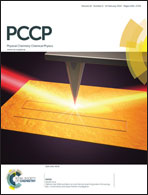Tuning the gallium content of metal precursors for Cu(In,Ga)Se2 thin film solar cells by electrodeposition from a deep eutectic solvent†
Abstract
Controlling the Ga incorporation of Cu–In–Ga metal precursors for Cu(In,Ga)Se2 (CIGS) solar cells is one of the main challenges for low cost electrodeposition processes, mainly due to the difficulty in electrodepositing metallic Ga from aqueous electrolytes. In this work we use the deep eutectic solvent (DES) Choline Chloride : Urea (ChCl : U – 1 : 2) to efficiently codeposit In–Ga on Cu and Mo electrodes. We control the Ga/(Ga+In) (Ga/III) ratio of the films via the mass fluxes. The electrochemical behavior of ChCl : U containing GaCl3 and InCl3 is studied by rotating disk electrode cyclic voltammetry (CV) on Mo and Cu electrodes. CV revealed on both Mo and Cu electrodes that the electrochemical behavior of the ChCl : U–GaCl3–InCl3 system is the superposition of the individual In and Ga electrochemistry. On a Cu electrode the morphology, crystal structure and element distribution of the deposits were a function of the Ga/III ratio. We demonstrate the precise control of Ga incorporation over a large composition range from 0.1 ≤ Ga/III ≤ 0.9 and proved that ED from DES is a straightforward, robust and efficient process. First solar cells based on Mo/Cu/In–Ga metal stacks achieved efficiencies as high as 7.9% with a Voc of 520 mV.


 Please wait while we load your content...
Please wait while we load your content...